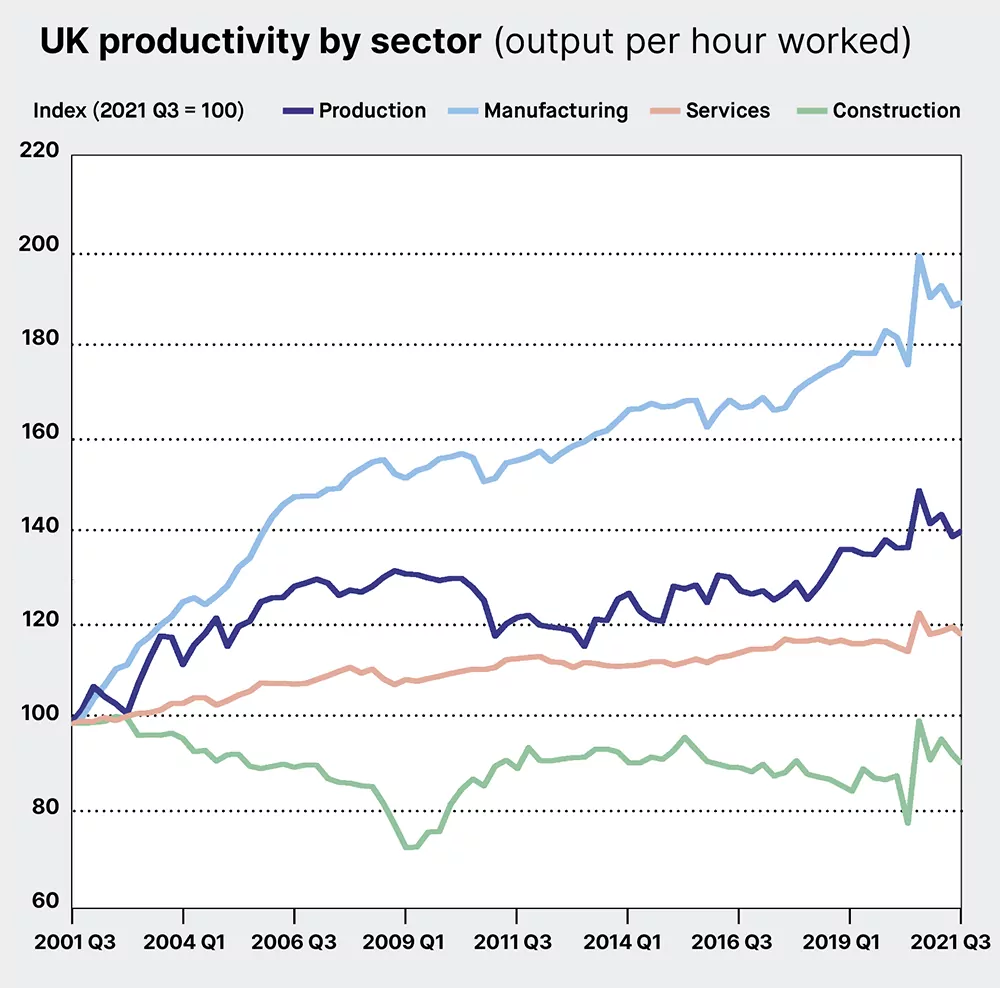Productivity in construction explains how adequately a contractor can complete the work with the available resource. Hence, achieving the optimum level of construction productivity would require proper planning and estimating construction materials at each stage of construction so that you can complete the work according to the plans.
Construction companies need to realize that investing in advanced technologies is an excellent way to increase productivity. There are great solutions on the market, like Epiprodux, that can help you provide superior production levels while cutting costs and improving safety.
What is Productivity in the Construction Industry?
Contractors know that productivity is the key to success. But what exactly is productivity in the construction industry?
Productivity measures how efficiently a company uses its resources to produce goods or services. Productivity can be measured by looking at output per unit of input or input per unit of production. This means that your productivity decreases if you have more employees working on a project and producing less. If you have fewer employees working on a project and making more, your productivity has increased.
Productivity can also be measured as output per hour worked. However, this measure is less useful because it ignores the time spent on other activities, such as meetings and training.
To understand how productivity relates to the construction industry, we must first look at how it relates to manufacturing. Manufacturing companies generally have one primary product that they produce, whereas construction companies often have multiple projects going on at once. This means they need help to measure how efficiently they are with their resources.
Why Should it Matter?
The construction industry is highly competitive, with many companies vying for the same clients, projects, and employees. To stay competitive, you must keep your company as efficient and productive as possible. This is where productivity software comes in.
Using software to track your team’s progress on each project, you can ensure that they complete tasks on time and within budget. This leads to more work and less money spent on mistakes and rework.
In addition to saving time and money, productivity tracking software can also help you find ways to improve how your team works together. When you see precisely how long each task takes and how often tasks are completed late or incorrectly, you can start looking for ways to make things run more smoothly.
Suppose a particular employee consistently has trouble meeting deadlines or always makes mistakes when he does finish early. In that case, that’s where you should focus your efforts to improve the quality of your company’s work overall.
Related: Procurement in Construction
Ways to Improve Productivity in Construction
Improving productivity is an essential aspect of construction. Construction workers must be able to complete their tasks on time and in a safe and efficient manner. There are many ways to improve productivity in construction, including the following:

Hire the right people. It would be best if you had reliable employees who would get the job done on time and within budget. That means hiring people with the right skills, experience, and attitude for the job.
Use the right tools for the job. One of the best ways to increase your productivity your tools need to be of high quality and should be appropriate for your needs. Using the right tool for a job will speed up your progress and save time and energy.
Invest in automation. Automation can be expensive in some cases, but it’s well worth it to increase productivity on large projects. You’ll need fewer workers if you have automated machinery for laying concrete or drilling holes for nails. Your company can save money while still doing good work quickly and efficiently.
Keep things organized. When work areas are disorganized, it can lead to unnecessary delays and increased costs. Keeping things tidy allows employees to get their jobs done quickly without having to stop and look for things they need every few minutes.
Use checklists. Pilots often use checklists before they take off on commercial flights, but they can be helpful in any situation where safety or quality control is an issue. For example, construction workers could use checklists when performing inspections of buildings or equipment after repairs have been made so that they get everything necessary during their workday.
Organize your time wisely. Many construction projects involve more than one person working at once, so it can be easy for people with similar jobs.
Why is Productivity Important in Construction?
In a constantly evolving world, one of the essential aspects is productivity. Progress is made by moving forward and improving upon what you already have. You can build upon existing ideas or create new ones entirely.
The construction industry has seen a lot of changes over the years, but one thing has remained constant: The need for productivity. Construction companies that have invested in tools and technology have increased their output and made more money than their competitors.
Here are some reasons why productivity is so crucial in construction:
Safety
The most important reason for being concerned about productivity is safety. The more productive you are, the safer you are likely to be. Construction workers get injured at a rate five times higher than the average worker in other industries.
There are many reasons for this high construction injury rate, but one of them is a lack of productivity. When workers are not productive, they tend to rush and make decisions that put themselves and others at risk. The solution is simple: be more productive!
Quality Control
Productivity also plays an important role when it comes to quality control. The more productive your team is, the better will be their ability to respond quickly if there are any problems during construction projects or if there’s anything that needs improving or doing over again because it didn’t turn out exactly as planned during a previous phase of your project.
Increased profits
You may be asking yourself, how can productivity increase profitability? There are many answers to this question. The first answer is that it saves money. If you have a small crew and you can complete the same amount of work in a shorter amount of time, you will be able to charge your customers more per hour. This will result in more profit for your company because they are paying less per hour.
Another reason increased productivity can help with profitability is that it helps cut down on overhead costs and other expenses related to running your company.
Improve workflows
One of the most significant benefits of improving productivity in construction is that it allows you to improve your workflow and streamline your processes. This can help you reduce waste from inefficient systems or poor communication between team members within your organization, which will save time and money while improving customer satisfaction.
You should identify different workflows for each project and then improve them based on your findings. For example, if you find that there are too many steps involved in each workflow, then you can eliminate some steps from the process and see if it makes a difference in your overall productivity levels.
Factors Affecting Construction Productivity
Improving construction productivity results from understanding how the factors influence it. You can gather a lot of this information by studying construction key performance indicators, like those for estimating, scheduling, safety and materials management. Some of these factors include:
Technology Utilization
The first factor affecting construction productivity is technology utilization. In the construction sector, there are many ways in which you can use construction technology to increase productivity. Some of them include the following:
Development of computer software and hardware that can facilitate the management of projects, for example, scheduling software, project management software, and electronic document management systems.
Use of digital technology such as 3D modeling and virtual reality tools for industrial building construction design
Use of robotic machines for assembling prefabricated building systems in large-scale projects such as buildings, bridges, and dams
Workforce Skills Gap
The workforce skills gap is another factor affecting productivity in construction. It refers to the lack of skilled workers to complete specific jobs because they require a high level of expertise or knowledge, such as welding, electrical work, or plumbing.
The workforce skills gap can lead to poor quality of work or delayed completion of projects as skilled workers are always in demand, and there are not enough of them to go around all projects at once, leading to some construction projects being left behind while waiting for skilled workers who may never show up!
Workplace Conditions
The work environment directly impacts construction productivity in every industry, including construction. If your employees are working in an environment that doesn’t support productivity, it will be very difficult for them to deliver quality results within the stipulated time frame.
To ensure this does not happen, it’s vital for you as a project manager to consider all factors before choosing a site for construction activities, such as location, weather conditions, and safety factors, among others, so as not to affect productivity in any way possible.
Work Force Management
Workers who are trained in their craft can more efficiently complete tasks. When they understand the construction project they are working on, they can better meet deadlines and quality standards. In addition, if workers know what other workers on the job site are doing, they can anticipate what needs to be done next and complete their part sooner.
For example, if a bricklayer knows that a plumber needs access to electricity for his work later in the day, he may want to lay bricks for an electrical wall outlet at that time so that he does not need to come back later to complete his task. Another way to increase worker productivity is by assigning them construction tasks based on their skill level so that those with more experience can handle more challenging work than those with less experience.

How is Productivity Measured in Construction?
Measuring productivity is the key to success in any business. The construction industry is no different. It’s probably more critical for the construction industry to measure productivity because the costs of mistakes and errors are so high.
You can measure productivity in different ways and at varying levels of detail. For example, construction productivity can be measured by:
- Output per person-hour.
- Output per machine hour.
- Output per square meter.
- Output per unit of labor cost.
- Production per unit of capital cost.
Construction productivity is usually measured in terms of output per unit of input. The ratio of input to output varies according to the type of industry and the nature of the production process being analyzed. You may measure output in quantity or value, for example, tons produced or dollar value added to an intermediate product (e.g., a steel mill). Inputs may include building materials used and labor required to produce them; these inputs will vary according to the production process’s complexity.
Measuring Construction Productivity With Productivity Software
Construction labor productivity has increased only 1 percent annually over the past two decades. Construction companies could be more productive if they focused on developing profitable products.

Improving productivity can be achieved by focusing on value creation for customers. However, many companies struggle due to low-quality project management, inadequate design processes and underinvestment in skills development and innovation.
Companies that excel at digitalization and manage construction projects as digital twins of their products gain higher margins by building in extra time to troubleshoot problems. With EpiProdux, your future projects will be less costly, and profitable.
Try it for free today


